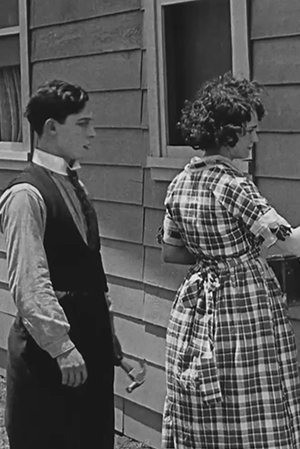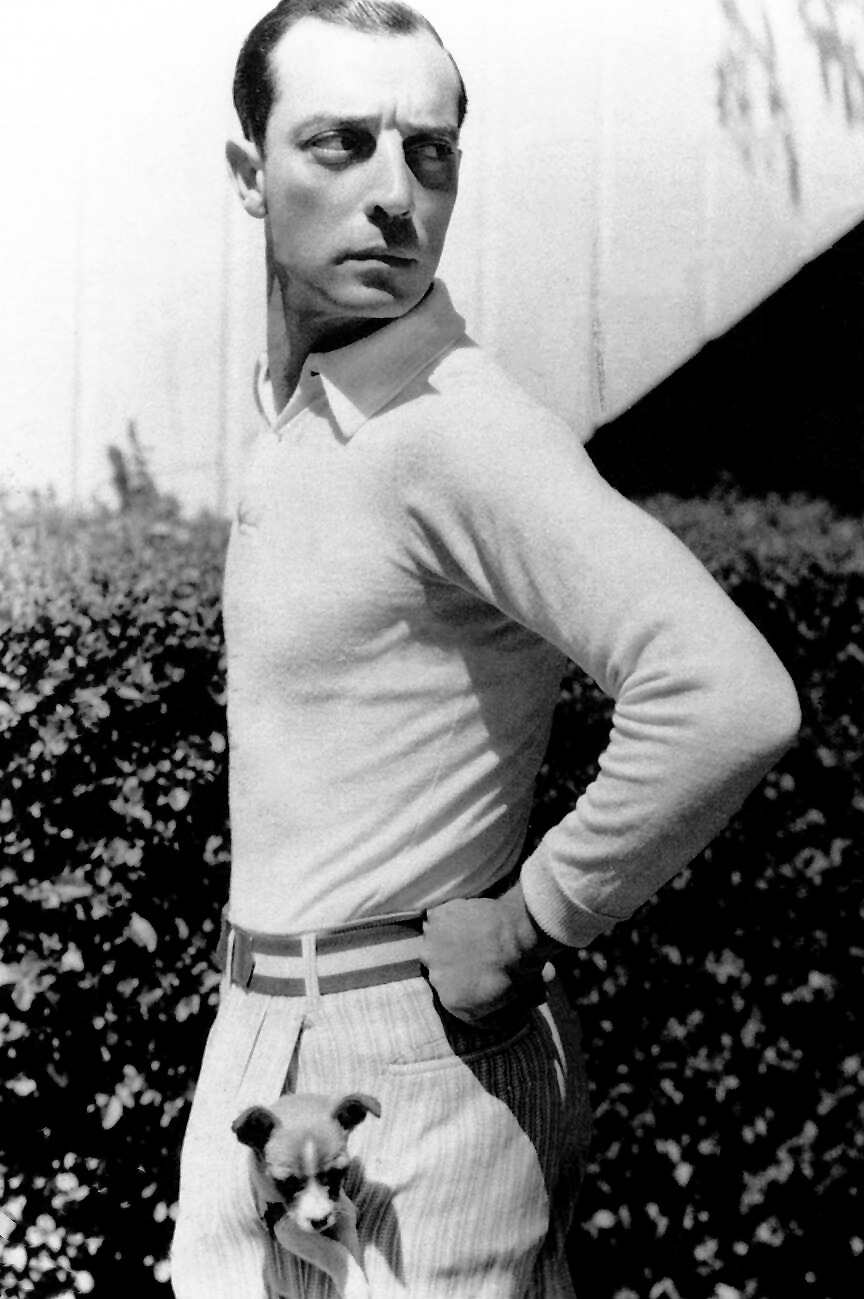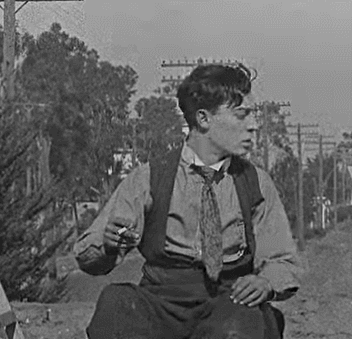Uma
das razões para o sucesso da Nova Hollywood - nome utilizado para se referir
aos cineastas que começaram suas carreiras no final da década de 1960 e início
de 1970 - foi que eles não eram apenas cineastas: eram também cinéfilos. O exemplo
máximo é Martin Scorsese, que tem até uma fundação para preservar e restaurar
filmes antigos, e em documentários, assim como em seus filmes de ficção, já
demonstrou sua paixão pela História do Cinema. Peter Bogdanovich é outro nome
da Nova Hollywood que amava filmes clássicos - tanto que ele homenageou mais de
uma vez as comédias malucas. O último filme de Bogdanovich foi um documentário
sobre o grande Buster Keaton, um filme bastante informativo sobre este ícone
inesquecível.
One of the reasons for the success of the New Hollywood – a name used to refer to filmmakers who started in the late 1960s and early 1970s – was that they weren’t only filmmakers: they were also cinephiles. The maximum example is Martin Scorsese, who even has a foundation to preserve and restore old films, and in documentaries, just like in his fiction films, has demonstrated his passion for the History of Cinema. Peter Bogdanovich is another name from New Hollywood who loved classic movies – so much that he paid tribute more than once to screwball comedies. Bogdanovich’s last film was a documentary about the great Buster Keaton, a very informative film about this unforgettable icon.
Nós,
fãs de Buster Keaton, conhecemos a história. Buster nasceu em 1895 e, ainda
bebê, se juntou aos pais no palco. Ele cresceu como uma popular estrela de
vaudeville, se tornando, antes dos 10 anos de idade, o astro do número dos
Keaton graças às suas quedas - quedas que podem ter inspirado Houdini a dar ao
menino o apelido de Buster. Em 1917 ele adentra no mundo do cinema com Roscoe Arbuckle, que se tornaria seu mestre e amigo próximo, e em 1920 ele fez seu
primeiro longa-metragem, “O Pesado”.
We, Buster Keaton fans, know all the basics. Buster was born in 1895 and, as a baby, joined his parents on stage. He grew up as a popular vaudevillian, becoming, before he turned 10, the star of the Keatons’ act with his falls – falls that might have inspired Houdini to give him the nickname Buster. In 1917 he enters the movie world with Roscoe Arbuckle, who would become his professor and close friend, and in 1920 he made his first feature, “The Saphead”.
Walter
Kerr, famoso escritor, disse que assistir ao primeiro curta-metragem solo de
Buster, “One Week”, é como ver um jardim no exato momento de florescer. Todos
os curtas são mencionados e vemos clipes deles, provando que Buster, com vinte
e poucos anos, já era um cineasta genial.
Walter Kerr, a famous writer, said that watching Buster’s first released solo short, “One Week”, is like seeing a garden in the exact moment of blooming. All his shorts are mentioned and we see clips of them, proving that Buster, in his mid-20s, was already a genius filmmaker.
Buster
nunca trabalhou com um roteiro na década de 1920. Ele sabia o começo e o fim
dos seus filmes, mas como ele disse, “o meio tomará conta de si mesmo”. Isto
muda quando ele se associa à MGM, e sua carreira sofre. Ao mesmo tempo, Buster
tem que encarar o fim da era muda no cinema, o fim de seu casamento, seu vício
em álcool e uma nova maneira de fazer filmes na MGM.
Buster never worked with a script during the 1920s. He knew the beginning and the ending of his films, but, as he said, “the middle would take care of itself”. This changes when he joins MGM, and his career suffers. At the same time, Keaton has to face the end of the silent era, the end of his marriage, his drinking addiction and a new way of making pictures at MGM.
Há
várias manchetes de jornal mostradas ao longo da vida e carreira de Buster,
incluindo algumas da época em que ele foi demitido da MGM e sofreu um colapso
nervoso, o que o levou a uma hospitalização. Os jornais disseram que ele se
aposentaria e nunca mais trabalharia no cinema, o que provou ser uma mentira
após ele voltar à sobriedade. Ele encontra trabalho novamente com a Educational
Pictures e depois com a Columbia, mas os filmes que faz nessa época são tão
ruins que o próprio Buster os chama de “traições”.
There are several newspaper headlines shown throughout Keaton’s life and career, including some from the time he was fired from MGM and had a nervous breakdown, which made him be hospitalized. Newspapers said that he would retire and never work again in film, which proved to be a lie after he became sober again. He finds work again with Educational Pictures and later Columbia, but the movies he makes at that time are so bad that Keaton himself calls them “cheaters”.
Felizmente,
Buster é salvo por seu último casamento. Em 1940 ele se casa com Eleanor
Norris, que se torna Eleanor Keaton, e é ela quem mais o apoia. Esse apoio vem
nos maus momentos e também quando as coisas começam a melhorar, com Keaton se
apresentando num circo internacional, na TV, fazendo comerciais e pontas em
filmes.
Luckily, Buster is saved by his last marriage. In 1940 he weds Eleanor Norris, who becomes Eleanor Keaton, and she is his biggest cheerleader. She supports him through bad and also when things start to look good again, with Keaton appearing at an international circus, on TV, making commercials and cameos in film.
Há
algo novo no documentário mesmo para os velhos fãs como eu. Eu nunca havia
visto alguns dos comerciais que Buster fez, nem seu episódio do programa de TV “This
is Your Life”, em que ele se emociona bastante. Isso prova que há sempre mais
sobre Buster para ser redescoberto e virar assunto de artigos. O documentário
também ousa ao escolher contar a vida toda de Buster e só depois analisar os
dez filmes - dez obras-primas! - que ele fez nos anos 20.
There is something new in the documentary even for old fans like me. I had never seen some commercials Buster did, as well as his “This is Your Life” TV episode, in which he’s deeply moved. This is proof that there is always more about Buster to be rediscovered and written about. The documentary also takes a bold turn by choosing to tell Buster’s whole life and then analyze the ten films - ten masterpieces! - he made in the 1920s.
Buster
foi apelidado de “great stone face” (“grande cara de pedra”), mas o documentário
nos faz lembrar que ele tinha olhos muito expressivos, algo que valia ouro no
cinema mudo. E não apenas nesta época: o diretor Jon Watts, de “Homem-Aranha:
De Volta para Casa” (2017), nos conta que se inspirou em Buster para criar as emoções
de um Homem-Aranha com rosto também inexpressivo, coberto por uma máscara.
Buster was nicknamed “the great stone face”, but the documentary reminds us that he had very expressive eyes, a feature that was like gold for silent cinema. And not only for that: director Jon Watts, from “Spider-Man: Homecoming” (2017), tells us that he was inspired by Buster to create the emotions of an also stone-faced Spider-Man, whose face is covered by a mask.
São
muitos os entrevistados no documentário: amigos de Keaton, como Dick Van Dyke,
atores, como Bill Hader e Mel Brooks, diretores, tais quais Werner Herzog e
Tarantino, dublês, historiadores, a exemplo de Leonard Maltin, e pesquisadores.
Todos eles falam sobre como Buster influenciou seus trabalhos, em especial com seus
feitos sobre-humanos sem o uso de dublês.
The “talking heads” in the documentary are many: friends of Keaton, such as Dick Van Dyke, actors, such as Bill Hader and Mel Brooks, directors, like Werner Herzog and Tarantino, stuntmen, historians, like Leonard Maltin, and researchers. They all talk about how Buster influenced their works, especially his super-human stunts.
O
produtor do documentário é Charles S. Cohen. De acordo com Bogdanovich, Cohen
adquiriu os direitos sobre a obra de Keaton e ofereceu ao cineasta a
oportunidade de fazer o documentário com todo o material de arquivo de que ele
dispunha - uma oferta que nem Peter, nem ninguém, poderia recusar. Bogdanovich
escreveu, dirigiu e narrou o documentário.
The producer of the documentary is Charles S. Cohen. According to Bogdanovich, Cohen got the rights over Keaton’s oeuvre and offered the filmmaker the opportunity to make a documentary with all the archival footage he got – an offer Peter, or anyone, couldn’t refuse. Bogdanovich wrote, directed and narrated the documentary.
Numa
entrevista para Ben Mankiewicz no TCM, Bogdanovich disse que fazer este
documentário foi só alegria e - polêmico! - que Keaton é melhor que Chaplin
porque o humor de Chaplin era demasiado Vitoriano, enquanto o humor de Keaton
era moderno. Mesmo assim, não havia animosidade entre eles: Eleanor Keaton
disse que Chaplin tratou Keaton como um rei quando eles filmaram a única cena em
que contracenaram, em “Luzes da Ribalta” (1952).
In an interview to Ben Mankiewicz on TCM, Bogdanovich said that making this documentary was a joy and – polemic! – that Keaton is better than Chaplin because Chaplin’s humor was too Victorian, while Keaton’s humor was modern. Nevertheless, there was a lovely relationship between them: Eleanor Keaton claimed that Chaplin treated Keaton like a king when they shot their only appearance together, in “Limelight” (1952).
Leonard
Maltin diz que Buster Keaton sempre se esforçou 100% para fazer todas as coisas
que fez. É por isso que ele teve êxito em seu objetivo máximo: nos fazer rir -
o que ele continua fazendo mesmo 100 anos após seu auge. É por isso que ele é o
Grande Buster Keaton.
Leonard
Maltin says that Buster Keaton always gave 100% of his efforts to all the
things he did. That’s why he succeeded in his ultimate goal: to make us laugh –
which he keeps doing despite it’s been 100 years since his heyday. This is why
he is the Great Buster.
This
is my contribution to the 10th Annual Buster Keaton blogathon,
hosted by Lea at Silent-ology.



%2Bcamera.png&f=1&nofb=1&ipt=4237016d935f241c0c85728a7cd7674a5cb4738983abec1fa762055398e3ca42&ipo=images)








The Great Buster is one of my fave documentaries. Peter Bogdanovich wrote a moving and heartfelt love letter to Buster, didn't he? Your review did the film justice, and now I want to see it again right away.
ReplyDeleteHi Lê. I love that documentary and I love your post. Peter Bogdanovich (I hope I spelled his name correctly) did a wonderful job. As always, I enjoyed reading your posts.
ReplyDeleteI've been meaning to see this and now my curiosity is REALLY piqued. Plus: Buster and Werner Herzog in one film? Yes please! Thank you for this piece, and for contributing it to the blogathon!
ReplyDelete